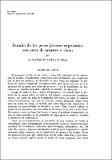Por favor, use este identificador para citar o enlazar a este item:
http://hdl.handle.net/10261/89471COMPARTIR / EXPORTAR:
 SHARE
BASE SHARE
BASE
|
|
| Visualizar otros formatos: MARC | Dublin Core | RDF | ORE | MODS | METS | DIDL | DATACITE | |

| Título: | Estudio de los peces jóvenes capturados con artes de arrastre o "bou" |
Autor: | Planas, Antonio; Vives Galmes, Francisco; Suau, P. | Fecha de publicación: | 1955 | Editor: | Consejo Superior de Investigaciones Científicas (España) | Citación: | Investigación Pesquera 2: 55-83 (1955) | Resumen: | [EN] This paper is based on the study of that part of the trawl catches that ordinarily is returned to the sea. Every month, representation and length distribution of a number of selected species has been secured, from fishing craft operating near Vinaroz (Western Mediterranean). As an introduction to further discussion, a brief summary of the biology of the most important commercial species is given. Special attention has been devoted to the study of migration in Mullus; very young red mullets appear in superficial waters, being attracted by the lamps used in fishing pilchards, and then hardly distingishables from young pilchards, being not by the barbels. The red mullets go to bottom between 15 snd 25 fathoms, then partly advance shoreward, later this movement is reversed and, as growth proceeds, the fishes moves seaward. The records of the apparition of young fishes of the different species in the bottom catches show an overwhelming introduction of the younger classes between May and September. It is suggested that a reduction by law of the fishing effort during these months would help greatly the regeneration of the fishing stocks and, if followed by the adoption of larger meshes in the nets, would improve the relatively poor fishing grounds of the studied region. [...] Gadus capelanus, Trachurus trachurus subsp. trachurus, Trachurus trachurus mediterraneus, Mullus barbatus, Mullus surmuletus, Sepia officinalis, Penaeus caramote, Pagellus mormyrus, Sparus aurata, Mustelus mustelus, Octopus vulgaris, Solea solea, Gobius sp., Euchitharus linguatula, Pleyronectes arnoglosus, Loligo vulgaris, Squilla mantis, Merluccius merluccius, Trigla gurnardus, Eledone moschata, Cepola rubescens, Eledone aldrovandi, Lophius piscatorius, Trigla hirundo, Clupea sprattus, Nephrops norvegicus, Raia sp., Paracentropristis hepatus, Spicara chryselis, Lepidotrigla cavillone, Scylliorhinus canicula, Scylliorhinus stellaris, Trigla cuculus, Spicara smaris, Scorpaena sp., Scorpaena scrofa, Boops boops, Sardina pilchardus, Palinurus vulgaris [...] [ES] El presente estudio se ha hecho a base del contenido de las «muestras de fondo», considerando como tales todo el material que, capturado con el arte de arrastre, es devuelto al mar luego de separado el producto de interés industrial. Podríamos decir, por tanto, que son los desperdicios de la pesca con artes de arrastre, y así lo consideran los pescadores de nuestra localidad, dándole el nombre de «basura». Luego de izado el bou a bordo del pesquero, es vaciado todo el producto de la calada sobre la cubierta del mismo, comenzando inmediatamente, por parte de toda la tripulación del navío, la labor de separar todos los ejemplares que, por su tamaño, hayan alcanzado algún valor para su venta en lonja. [...] |
Descripción: | 29 páginas, 9 cuadros, 12 figuras | Versión del editor: | http://www.icm.csic.es/scimar/index.php/secId/8/IdArt/1447/ | URI: | http://hdl.handle.net/10261/89471 | ISSN: | 0020-9953 |
| Aparece en las colecciones: | (IIP) Investigación Pesquera |
Ficheros en este ítem:
| Fichero | Descripción | Tamaño | Formato | |
|---|---|---|---|---|
| Planas_et_al_1955.pdf | 361,1 kB | Adobe PDF |  Visualizar/Abrir |
CORE Recommender
Page view(s)
337
checked on 26-abr-2024
Download(s)
100
checked on 26-abr-2024
Google ScholarTM
Check
NOTA: Los ítems de Digital.CSIC están protegidos por copyright, con todos los derechos reservados, a menos que se indique lo contrario.
